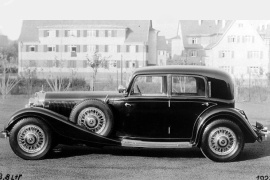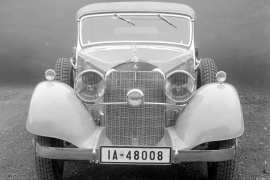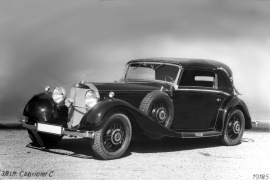MERCEDES BENZ Typ 380 Models/Series Timeline, Specifications & Photos
First production year: 1933
Engines: Gasoline
The 380 model was unveiled at the 1933 International Motor and Motorcycle Show in Berlin. The 380 served as the successor to the legendary six-cylinder supercharged "SS" and "SSK" models.
The 380 model (W 22) was a typical product of changing times. These changing times arrived at Daimler-Benz in the early 1930s and were ushered in above all by technical director Dr. Hans Nibel and his chief designer, Max Wagner. It was a transition model, which tried to get rid of the rigid axles and introduce the new swing-axle in the back and front independent suspension with coil springs.
On the outside, the 380 kept the distinctive pointed radiator grille. At the beginning of the 20th century, that shape was a common stylistic feature to more car-makers. In the 1920s, it started to fade away from the market, but it continued to be installed on the large supercharged models from Mercedes-Benz.
The 380 was offered as a convertible, coupe, four-door sedan, and chassis with engine and steering for further coach-builders. Some customers chose the latter version not because it was cheaper but because they wished a custom-built bodywork.
There were three different engine versions brought out in three years. Along with a six-cylinder unit, Daimler-Benz developed an inline-eight with side-valves that failed to live up to expectations. It was rebuilt with overhead valves and offered 90 hp in naturally aspirated version or 120 hp with the help of a supercharger. A third version was fitted with a different supercharger offering up to 140 hp. The last in the line was a 4.0-liter unit with a supercharger that provided the same output. All of them were mated to a three-speed transmission with overdrive.
One of the rarest versions of the Typ 380 W22, the Cabriolet B was designed for those trying to enjoy driving fast, in comfort, on the famous German Autobahn.
At the Berlin Motor Show in February 1933, Mercedes-Benz introduced the Typ 380 Series. The lineup looked fresh and modern, marking the rebirth of the German automaker after the Big Depression from the beginning of the '30s, which was almost gone. The Cabriolet B was designed as an open-top grand tourer that boasted not only a luxurious appearance but also a powerful, straight-eight engine.
Sharing its front fascia with the rest of the W22 series, the Cabriolet B featured a V-shaped radiator surrounded by a chromed rim. In front of it, mounted on the inner parts of the front fenders, the automaker installed a bar that supported the headlights, an additional third headlamp, and a powerful horn. Moreover, a bumper mounted directly on the chassis' endings protected the bodywork against light crashes. From its profile, the two-door convertible showed the long, valanced front fenders continued by the side steps. Finally, at the back, a sloped, arched-down trunk completed the car's luxurious look.
The cabin featured two bucket seats at the front and a bench in the rear, which was offered as an option. An interesting feature of the vehicle was the possibility of rolling down the rear side windows, even though there were no doors there. The driver was spoiled with a big, four-spoke steering wheel, while the instrument panel with dials and gauges was placed on the dashboard's center.
Underneath the long hood, the powerplant offered enough power to send this convertible to speeds above 120 kph. The car was praised for its comfort thanks to its independent front suspension and rear swing axles.
It was the changing era for Mercedes-Benz and, in 1933, it unveiled the Model 380 (W22) at the International Motor and Motorcycle Show in Berlin.
A new era began for the German carmaker when Dr. Hans Nibel and the chief designer Max Wagner tried to make a new roadster to replace the former 500K and the SSK. Everything was new on the new 380 model, from the sport chassis to the engine and bodywork.
The carmaker installed the engine further back behind the front axle for better weight distribution. Its pinned-out shape of the radiator grille was typical for the German carmaker, while other brands already started to stop using it. Its three headlights system was supported by an arched, transverse bar mounted between the ample wheel-fenders. On the sides of the engine compartment, the carmaker installed two spare wheels.
Inside the cabin, Mercedes-Benz installed a wood dash panel where the instrument panel took center stage. Its five-dials and gauges, plus a clock, offered a sporty image for the German convertible. Since the engine was pushed backward, the cabin had to be moved further back and forced the engineers to create a dual-arched gear-stick that started well under the dashboard. Its two seats were leather upholstered.
Mercedes-Benz launched the 380 with an inline-six engine but replaced it soon with an inline eight with or without a supercharger. Worth mentioning that the carmaker offered the possibility to install it afterward. Later on, in 1934, it introduced the inline-eight with over-head valves and built-in compressor, plus an enlarged displacement up to 4.0-liter. The three-speed manual with overdrive was the only option. Worth mentioning that the 380 featured independent suspension in all corners with a new trapezoidal system at the front and swing axles in the rear, plus coil springs. Due to the car's weight, Mercedes-Benz installed hydraulic brakes on the 380.


